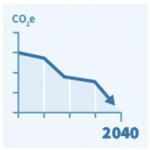Syska Hennessy’s Jennifer Kuether and Work Design’s Cynthia Milota outline how MEP 2040 is challenging engineering design firms to achieve net-zero carbon emissions in their projects by 2040, highlighting strategies for reducing embodied carbon, cutting operational costs, and optimizing building systems for sustainability.
MEP 2040: Definition, Implementation and Cost Savings
Buildings account for 40% of carbon emissions. And MEP systems (mechanical, electrical and plumbing) contribution to carbon range from 15-70% of a building’s embodied carbon, (Annan, n.d.).
MEP 2040 is a challenge presented to MEP engineering design firms to make a commitment to achieving net zero carbon emissions in their projects by 2040. Net zero refers to balancing greenhouse gases that go into the atmosphere with those taken out of the atmosphere. MEP 2040 focuses specifically on reducing the carbon footprint of building engineering systems, where the Architecture 2030, aims to make all new buildings and renovations carbon neutral by 2030, (MEP 2040).
Defining the Term: Embodied Carbon & Carbon Footprint
Embodied carbon refers to the CO₂ emissions associated with the materials, production, transportation and construction of a building before it becomes operational.
Carbon footprint is a broader term which encompasses all the greenhouse gas emissions associated with an activity, product or organization, including its operations and demolition.
MEP 2040 Evolution and Description
The global MEP 2040 movement evolved from a group of CLF (Carbon Leadership Forum) members in 2021, who were inspired by a similar challenge set forth for structural engineers, SE 2050. Reducing these greenhouse gases is a critical step in preventing rapid further warming of the earth, creating a more habitable environment for all.
Defining the Term: Carbon Leadership Forum (CLF)
The CLF is a non-profit organization dedicated to eliminating embodied carbon in buildings and infrastructure.
MEP 2040 requires both advocacy and action to meet the net zero goals outlined for the set timeline. The commitments, as described on the MEP 2040 website, are 1) sign the commitment, 2) make a company plan, 3) request low-GWP (Global Warming Potential) refrigerants, request EPDs (Environmental Product Declarations) in MEP specifications, and 4) participate in quarterly forums.
Get started with MEP 2040

MEP design firms can best achieve the goals of MEP 2040 becoming a signatory of MEP 2040. An important first step: it signals to the world that a firm is ready to not only work internally to reduce carbon emissions, but also to collaborate with adjacent team members – e.g., building owners, product manufacturers, and architects – to achieve a common goal.
1. Establish a Company Plan

Establishing a company plan for achieving net zero carbon emissions provides guidelines and can also establish accountability for firms that list specific checkpoint goals prior to the year 2040.
2. Request low-GWP refrigerants

Requesting low-GWP refrigerants for refrigeration and air conditioning systems will reduce the amount of heat trapped in the atmosphere. Utilization of low-GWP refrigerants can also reduce lifecycle cost due to the increased efficiency that they create for a system.
Defining the Term: Global Warming Potential (GWP)
GWP refrigerants have a lower capacity to trap heat in the atmosphere compared to traditional refrigerants.
3. Request EPDs

MEP design firms should request EPDs as part of tracking their goals for MEP 2040. EPDs include quantifiable data, which is typically verified by third-party organizations. Some examples of this data include waste generation, energy consumption, water use and/or embodied carbon.
Defining the Term: Environmental Product Declaration (EPD)
An EPD is a transparent document that displays a product’s environmental impact throughout the product lifecycle.
An EPD does not necessarily constitute an environmentally safe product.
However, the more that EPDs are requested, the more that product manufacturers will be encouraged to improve their products so that they have less of a negative environmental impact. The environmental impact of EPDs is assessed according to specific PCRs (Product Category Rules), which create a level playing field for comparing like products. If design engineers can view the EPDs for various specified products side by side, they can make an informed decision on selecting a product that works best for both their client and the environment.
4. Participate in Forums

When MEP firms participate in the MEP 2040 quarterly forums, they are keeping up to date on the ever-changing trends and technology associated with being environmentally mindful. Collectively achieving a common goal with partners within the same industry provides mentorship, encouragement and a growing body of knowledge.
Cost Savings
Adopting MEP 2040 practices can contribute to cost savings by:
- Reducing operational costs via energy efficient HVAC systems, optimized lighting and water management strategies.
- Extending equipment lifespan via more efficient and durable systems, reducing the need for frequent repairs and replacement.
- Reducing carbon footprint and compliance can lead to lower carbon emissions taxes and regulatory compliance.
- Increasing value and marketability as sustainable buildings command higher values, attract tenants who prioritize environmental options and are willing to pay a premium.
- Potential to reduce initial costs through strategies such as limiting window to wall ratios to reduce heating/cooling loads/equipment or conversely the use of natural light/windows to reduce the quantity of light fixtures.
- Collaboration and innovation of knowledge sharing and best practices will drive down costs via innovative solutions.
The key to maximize savings is to optimize MEP systems for operational efficiency.
MEP 2040 – Call to Action
MEP 2040 developed “The Beginner’s Guide to MEP Embodied Carbon.” This comprehensive document discusses “Cradle to Gate Embodied Carbon” reporting and management; “Beyond the Gate” strategies for everything from transport impacts to life-cycle stages; and multiple case studies for products and projects.
Defining the Term: Cradle to Gate Embodied Carbon
This term refers to emissions associated with only the production of building materials from raw material extraction to the manufacturing of finished products, also referred to as “supply chain carbon,” (ASHE, 2023).
MEP 2040 “Beginner’s Guide” examines the stakeholders integrated into this process as outlined below:
Manufacturers’ EPRs minimize the environmental impact of their products by disclosing product components, designing for durability and disassembly, initiate take-back programs and sparking innovation through research and development.
Defining the Term: Extended Producer Responsibility (EPR)
EPR is a concept where the manufacturer or brand owner takes operational and/or financial responsibility for a product at the end of its useful life.
Designers to call for EPDs and other LCA data as they investigate product options; implement carbon submittal requirements; specify disposal procedures and collaborate with all stakeholders of the project process.
Defining the Term: Life Cycle Assessment (LCA)
LCA is a method for evaluating the environmental impacts of a building through out its entire lifespan, from extraction of raw materials to demolition and disposal, (One Click, LCA, 2021).
Owners of properties can set emission goals, including requirements for whole life carbon assessments, reduce construction emissions and track refrigerant leakage.
Contractors can source low-carbon materials and equipment, optimize material use and minimize waste, source locally and champion low carbon practices in contractual agreements.
Certification and policy makers are encouraged to include MEP embodied carbon and whole life accounting for operational carbon /refrigerants into building certifications to better understand the total carbon emissions over the life of a building.
Defining the Term: Whole Life Accounting
Whole life accounting, also known as life-cycle cost analysis (LCCA), is a method of evaluating the total cost of a building over its entire lifespan, from initial planning and construction to operation, maintenance and eventual disposal, (Wikipedia, n.d.).
The Bottom Line
In order to stop the rate of greenhouse gases contributing to the warming of the earth from buildings, it is important for MEP design engineering firms to take a stance and approach sustainable planning and design holistically. Non-engineers can participate in this movement as well by issuing a public statement advocating for MEP 2040 and supporting MEP firms that are signatories to MEP 2040. Your involvement is essential to track and reduce the embodied carbon in MEP systems.
Ready for Next Steps?

To stay informed subscribe to MEP 2040 News here.
All images courtesy of MEP 2040
References
Annan, G. (n.d.) “Reducing embodied carbon in building systems: from concept to practice, Retrieved from: Reducing Embodied Carbon in Building Systems: From Concept to Practice – Carbon Leadership Forum
ASHE, 2023, “Greenhouse gas management of embodied carbon in building materials,” Retrieved from: Greenhouse Gas Management of Embodied Carbon in Building Materials | ASHE
Houde, K., Jensen, A., Shinn K. (2025). The Beginner’s Guide to MEP Embodied Carbon. MEP 2040. Retrieved from: https://www.mep2040.org/download-guide
MEP 2040, (n.d.) “About MEP and Carbon, Retrieved from: https://www.mep2040.org/mep-and-embodied-carbon
One Click LCA, (2021), “Life Cycle assessment for buildings,” Retrieved from: Life-Cycle-Assessment-for-Buildings-2021.pdf
Wikipedia, (n.d.), “Whole-life cost,” Retrieved from: Whole-life cost – Wikipedia


